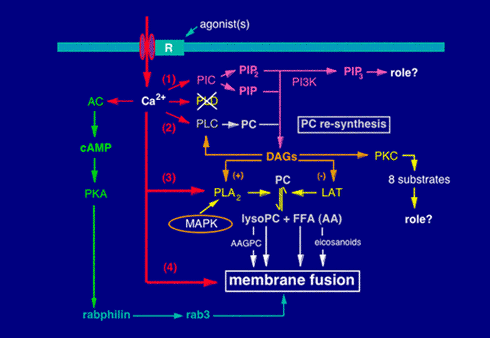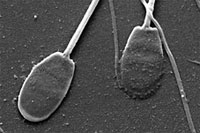Research

Before the mammalian spermatozoon can participate
in fertilisation it must undergo a series of changes. First, it must
undergo capacitation, a physiological "switching-on", that takes place
around the time of ovulation, in response to factors present in the
female tract, and that confers spermatozoa the capacity to interact
with the ovum. During its interaction with the female gamete, the spermatoozon
engages in mechanisms of cell-cell recognition and undergoes a process
of exocytosis of the acrosomal contents, the so-called "acrosome reaction".
This acrosomal exocytosis seems to occur in response to the combined
action of progesterone (a steroid present in the cells surrounding the
oocyte) and the zona pellucida (a glycoprotein coat of the oocyte).

 Considerable
efforts have been devoted to unravelling signalling pathways underlying
acrosomal exocytosis. We have characterised phosphoinositide and phosphatidylcholine
hydrolysis by various phospholipases C and the generation and roles of
diacyl- and alkyl-acyl-glycerols in response to molecular probes and physiological
agonists (Roldan and Harrison, 1989; Roldan and Murase 1994; Roldan et
al. 1994), demonstrating their essential function during exocytosis. The
participation of phospholipase A2 has also been addressed and
several studies have allowed us to characterise its essential role (Roldan
and Fragio 1993; Yuan et al. 2003; Shi et al. 2005), mechanisms regulating
enzyme activity (Shi et al. 2005; Chen et al. 2005), cross-talks with
other signalling pathways, and the participation of metabolites generated
by this enzyme in membrane function (Garde and Roldan 1996, 2000). Reviews
summarising current information are available (Brewis et al. 2005; Roldan
and Shi 2006).
Considerable
efforts have been devoted to unravelling signalling pathways underlying
acrosomal exocytosis. We have characterised phosphoinositide and phosphatidylcholine
hydrolysis by various phospholipases C and the generation and roles of
diacyl- and alkyl-acyl-glycerols in response to molecular probes and physiological
agonists (Roldan and Harrison, 1989; Roldan and Murase 1994; Roldan et
al. 1994), demonstrating their essential function during exocytosis. The
participation of phospholipase A2 has also been addressed and
several studies have allowed us to characterise its essential role (Roldan
and Fragio 1993; Yuan et al. 2003; Shi et al. 2005), mechanisms regulating
enzyme activity (Shi et al. 2005; Chen et al. 2005), cross-talks with
other signalling pathways, and the participation of metabolites generated
by this enzyme in membrane function (Garde and Roldan 1996, 2000). Reviews
summarising current information are available (Brewis et al. 2005; Roldan
and Shi 2006).Currently, we are interested in the different types of PLA2 that may be present in mammalian spermatozoa, how they are regulated, and their role in the molecular sequence leading to membrane fusion.
Collaborators:
• Qi-xian Shi, Department of Reproductive Physiology and Toxicology, Zhejiang Academy of Medical Sciences, Hangzhou, Zhejiang (People's Republic of China).
Back to projects